Analysis of Sainsbury's Business Strategy and Macro Environment Impact
VerifiedAdded on 2020/11/12
|20
|5727
|470
Report
AI Summary
This report provides a comprehensive analysis of Sainsbury's business strategy, examining the impact of the macro environment and the company's internal capabilities. It begins with an overview of business strategy and introduces Sainsbury's as a case study. The report then applies frameworks such as PESTAL and SWOT analysis to assess the external and internal environments, respectively. The VRIO framework and McKinsey's 7S model are employed to evaluate the company's resources, competitive advantage, and organizational structure. Furthermore, the report utilizes Porter's Five Forces model to assess competitive forces within the industry. Finally, it explores various strategic planning theories and models to interpret the strategic planning process. The report aims to provide a detailed understanding of Sainsbury's strategic approach and its position in the market.
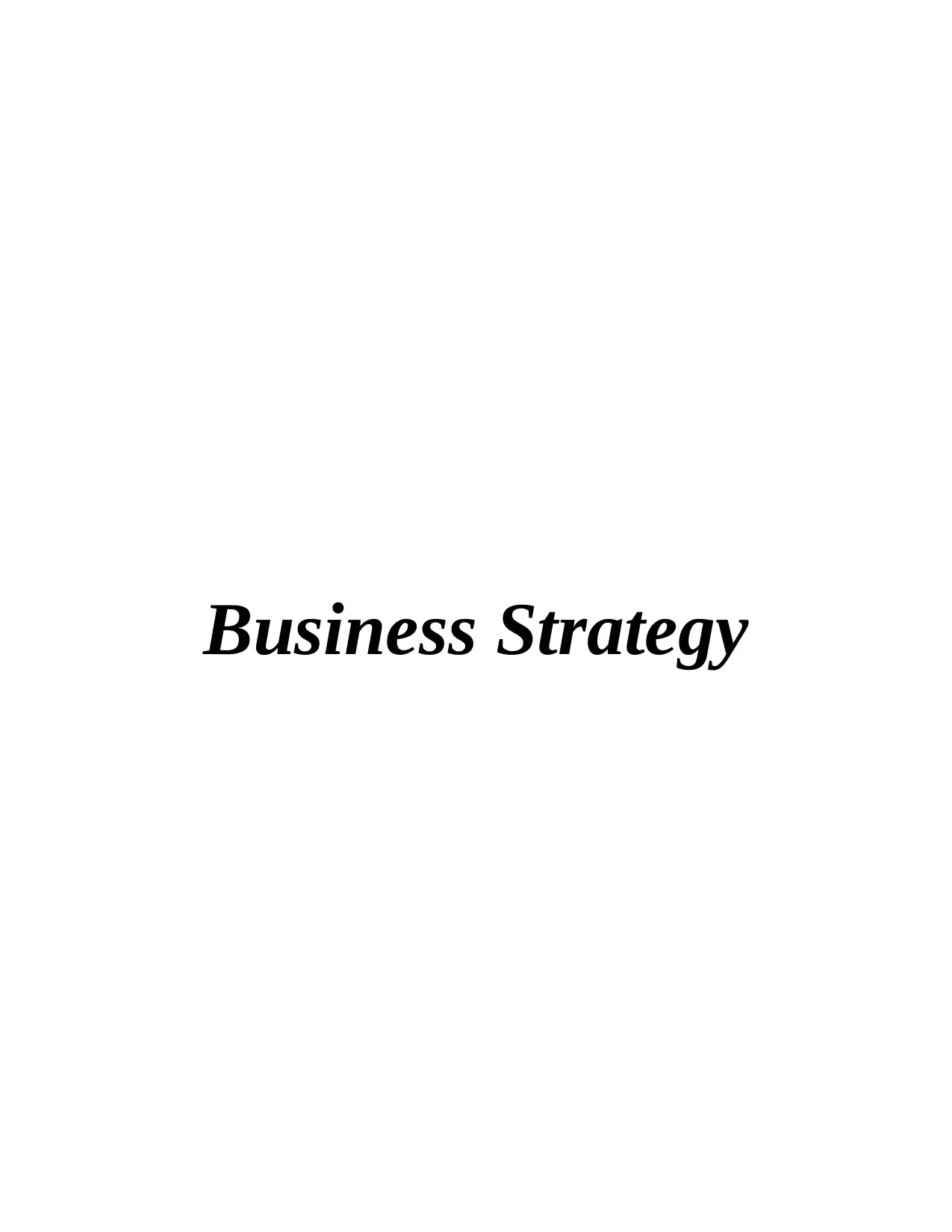
Business Strategy
Paraphrase This Document
Need a fresh take? Get an instant paraphrase of this document with our AI Paraphraser
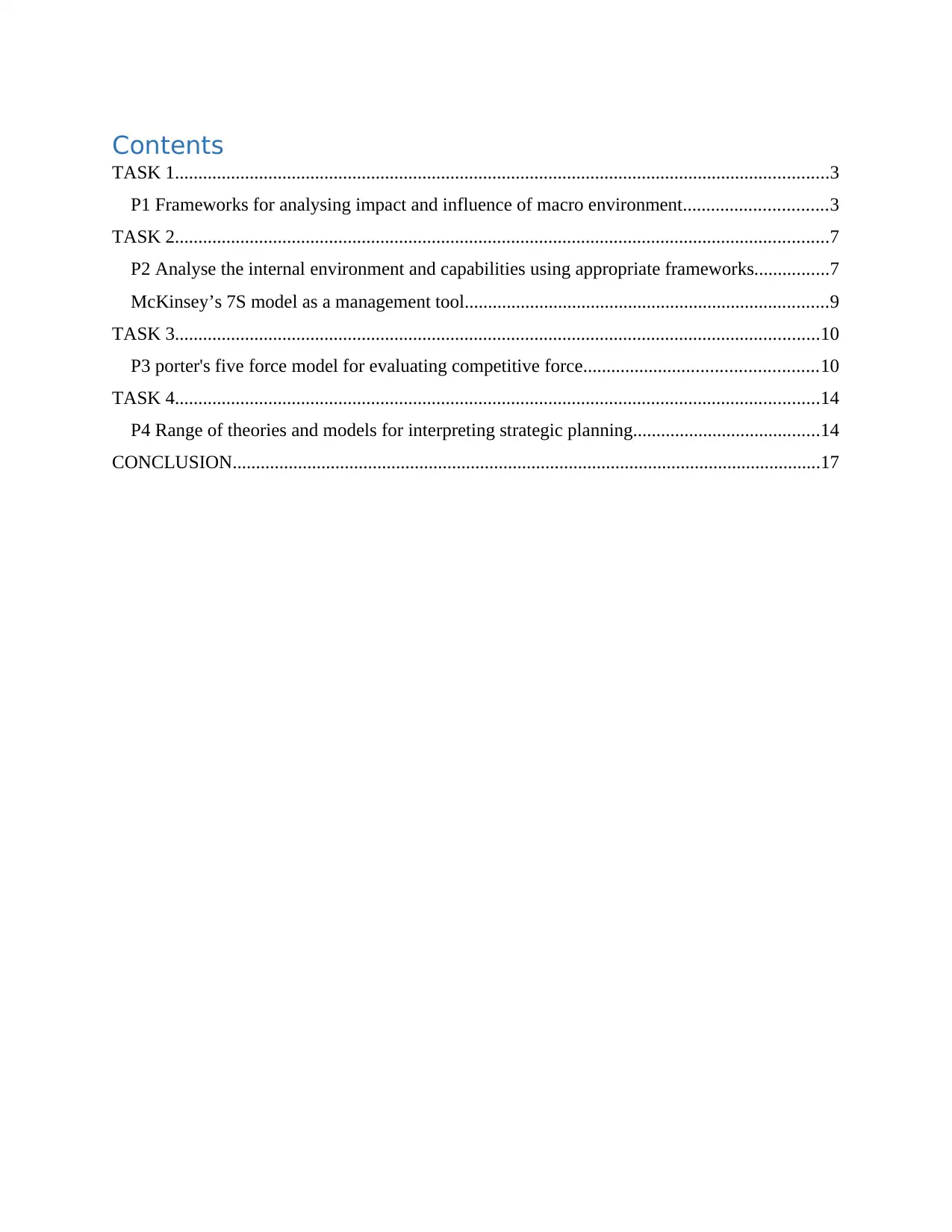
Contents
TASK 1............................................................................................................................................3
P1 Frameworks for analysing impact and influence of macro environment...............................3
TASK 2............................................................................................................................................7
P2 Analyse the internal environment and capabilities using appropriate frameworks................7
McKinsey’s 7S model as a management tool..............................................................................9
TASK 3..........................................................................................................................................10
P3 porter's five force model for evaluating competitive force..................................................10
TASK 4..........................................................................................................................................14
P4 Range of theories and models for interpreting strategic planning........................................14
CONCLUSION..............................................................................................................................17
TASK 1............................................................................................................................................3
P1 Frameworks for analysing impact and influence of macro environment...............................3
TASK 2............................................................................................................................................7
P2 Analyse the internal environment and capabilities using appropriate frameworks................7
McKinsey’s 7S model as a management tool..............................................................................9
TASK 3..........................................................................................................................................10
P3 porter's five force model for evaluating competitive force..................................................10
TASK 4..........................................................................................................................................14
P4 Range of theories and models for interpreting strategic planning........................................14
CONCLUSION..............................................................................................................................17
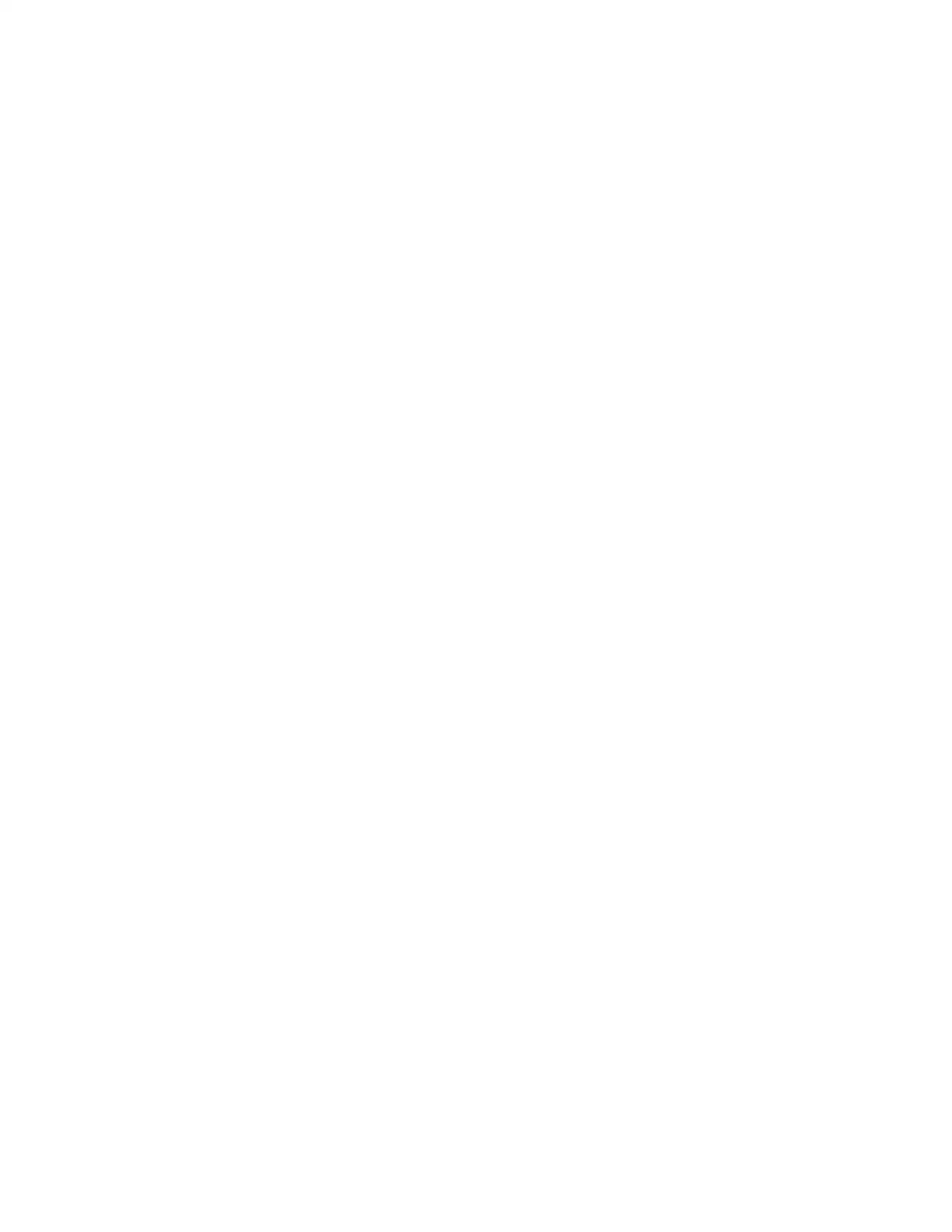
⊘ This is a preview!⊘
Do you want full access?
Subscribe today to unlock all pages.

Trusted by 1+ million students worldwide
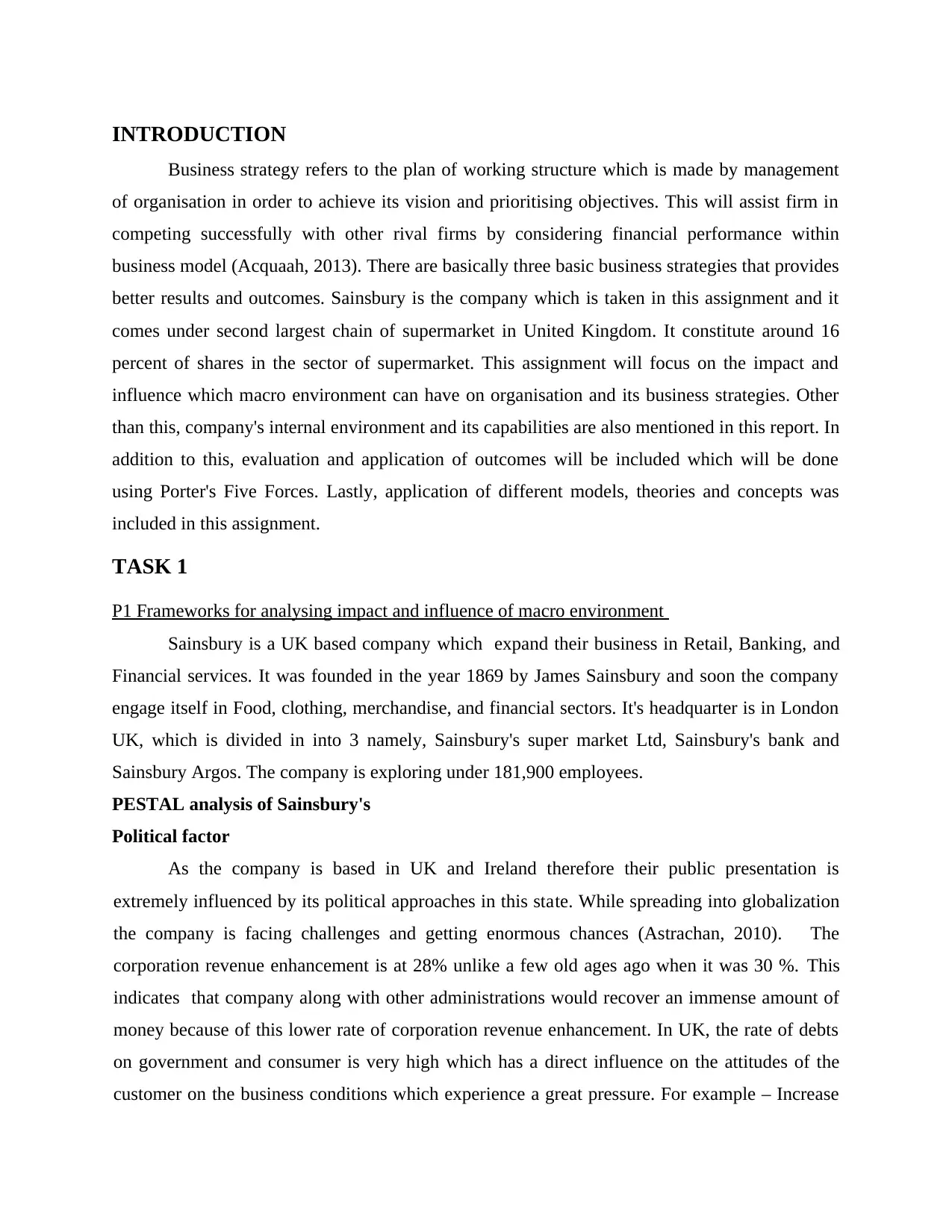
INTRODUCTION
Business strategy refers to the plan of working structure which is made by management
of organisation in order to achieve its vision and prioritising objectives. This will assist firm in
competing successfully with other rival firms by considering financial performance within
business model (Acquaah, 2013). There are basically three basic business strategies that provides
better results and outcomes. Sainsbury is the company which is taken in this assignment and it
comes under second largest chain of supermarket in United Kingdom. It constitute around 16
percent of shares in the sector of supermarket. This assignment will focus on the impact and
influence which macro environment can have on organisation and its business strategies. Other
than this, company's internal environment and its capabilities are also mentioned in this report. In
addition to this, evaluation and application of outcomes will be included which will be done
using Porter's Five Forces. Lastly, application of different models, theories and concepts was
included in this assignment.
TASK 1
P1 Frameworks for analysing impact and influence of macro environment
Sainsbury is a UK based company which expand their business in Retail, Banking, and
Financial services. It was founded in the year 1869 by James Sainsbury and soon the company
engage itself in Food, clothing, merchandise, and financial sectors. It's headquarter is in London
UK, which is divided in into 3 namely, Sainsbury's super market Ltd, Sainsbury's bank and
Sainsbury Argos. The company is exploring under 181,900 employees.
PESTAL analysis of Sainsbury's
Political factor
As the company is based in UK and Ireland therefore their public presentation is
extremely influenced by its political approaches in this state. While spreading into globalization
the company is facing challenges and getting enormous chances (Astrachan, 2010). The
corporation revenue enhancement is at 28% unlike a few old ages ago when it was 30 %. This
indicates that company along with other administrations would recover an immense amount of
money because of this lower rate of corporation revenue enhancement. In UK, the rate of debts
on government and consumer is very high which has a direct influence on the attitudes of the
customer on the business conditions which experience a great pressure. For example – Increase
Business strategy refers to the plan of working structure which is made by management
of organisation in order to achieve its vision and prioritising objectives. This will assist firm in
competing successfully with other rival firms by considering financial performance within
business model (Acquaah, 2013). There are basically three basic business strategies that provides
better results and outcomes. Sainsbury is the company which is taken in this assignment and it
comes under second largest chain of supermarket in United Kingdom. It constitute around 16
percent of shares in the sector of supermarket. This assignment will focus on the impact and
influence which macro environment can have on organisation and its business strategies. Other
than this, company's internal environment and its capabilities are also mentioned in this report. In
addition to this, evaluation and application of outcomes will be included which will be done
using Porter's Five Forces. Lastly, application of different models, theories and concepts was
included in this assignment.
TASK 1
P1 Frameworks for analysing impact and influence of macro environment
Sainsbury is a UK based company which expand their business in Retail, Banking, and
Financial services. It was founded in the year 1869 by James Sainsbury and soon the company
engage itself in Food, clothing, merchandise, and financial sectors. It's headquarter is in London
UK, which is divided in into 3 namely, Sainsbury's super market Ltd, Sainsbury's bank and
Sainsbury Argos. The company is exploring under 181,900 employees.
PESTAL analysis of Sainsbury's
Political factor
As the company is based in UK and Ireland therefore their public presentation is
extremely influenced by its political approaches in this state. While spreading into globalization
the company is facing challenges and getting enormous chances (Astrachan, 2010). The
corporation revenue enhancement is at 28% unlike a few old ages ago when it was 30 %. This
indicates that company along with other administrations would recover an immense amount of
money because of this lower rate of corporation revenue enhancement. In UK, the rate of debts
on government and consumer is very high which has a direct influence on the attitudes of the
customer on the business conditions which experience a great pressure. For example – Increase
Paraphrase This Document
Need a fresh take? Get an instant paraphrase of this document with our AI Paraphraser
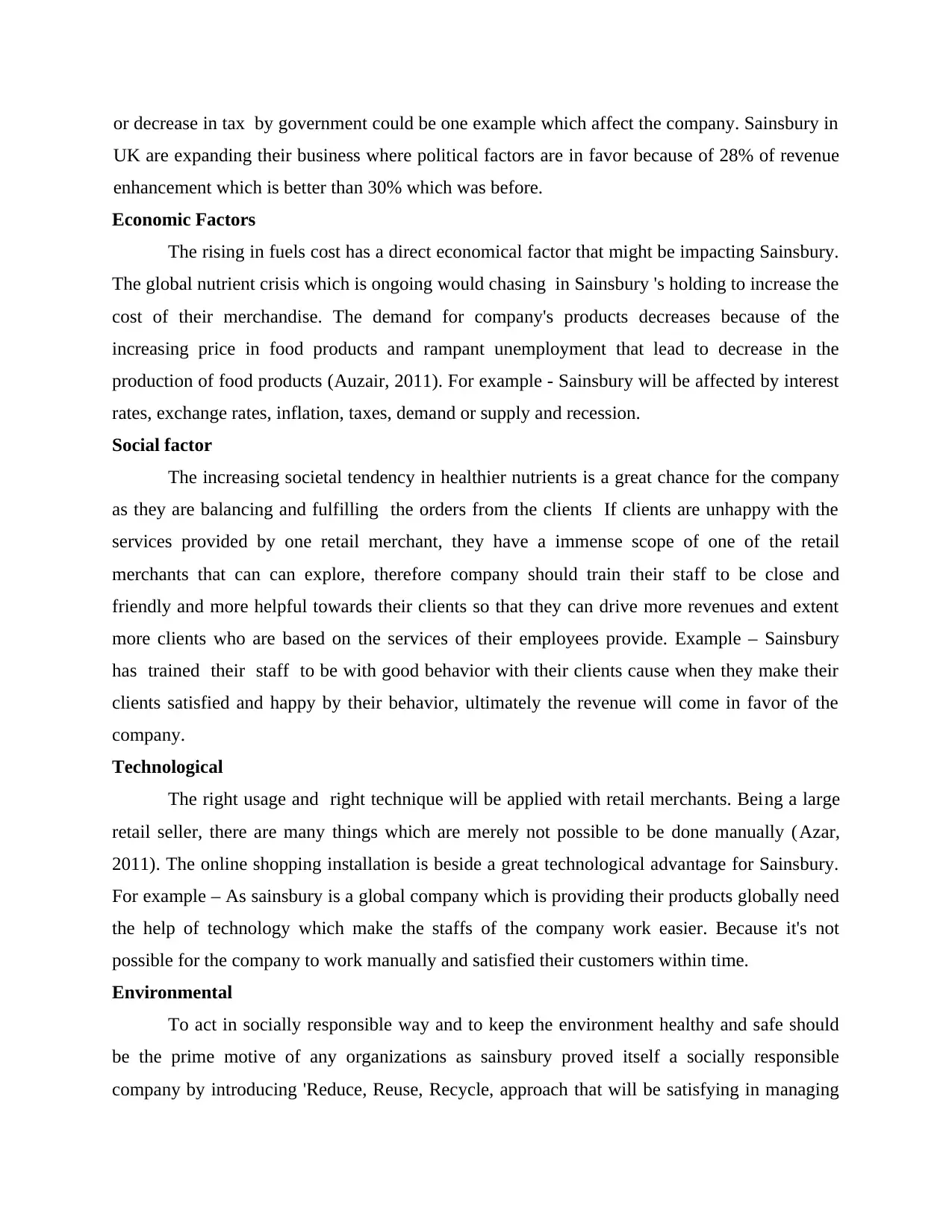
or decrease in tax by government could be one example which affect the company. Sainsbury in
UK are expanding their business where political factors are in favor because of 28% of revenue
enhancement which is better than 30% which was before.
Economic Factors
The rising in fuels cost has a direct economical factor that might be impacting Sainsbury.
The global nutrient crisis which is ongoing would chasing in Sainsbury 's holding to increase the
cost of their merchandise. The demand for company's products decreases because of the
increasing price in food products and rampant unemployment that lead to decrease in the
production of food products (Auzair, 2011). For example - Sainsbury will be affected by interest
rates, exchange rates, inflation, taxes, demand or supply and recession.
Social factor
The increasing societal tendency in healthier nutrients is a great chance for the company
as they are balancing and fulfilling the orders from the clients If clients are unhappy with the
services provided by one retail merchant, they have a immense scope of one of the retail
merchants that can can explore, therefore company should train their staff to be close and
friendly and more helpful towards their clients so that they can drive more revenues and extent
more clients who are based on the services of their employees provide. Example – Sainsbury
has trained their staff to be with good behavior with their clients cause when they make their
clients satisfied and happy by their behavior, ultimately the revenue will come in favor of the
company.
Technological
The right usage and right technique will be applied with retail merchants. Being a large
retail seller, there are many things which are merely not possible to be done manually (Azar,
2011). The online shopping installation is beside a great technological advantage for Sainsbury.
For example – As sainsbury is a global company which is providing their products globally need
the help of technology which make the staffs of the company work easier. Because it's not
possible for the company to work manually and satisfied their customers within time.
Environmental
To act in socially responsible way and to keep the environment healthy and safe should
be the prime motive of any organizations as sainsbury proved itself a socially responsible
company by introducing 'Reduce, Reuse, Recycle, approach that will be satisfying in managing
UK are expanding their business where political factors are in favor because of 28% of revenue
enhancement which is better than 30% which was before.
Economic Factors
The rising in fuels cost has a direct economical factor that might be impacting Sainsbury.
The global nutrient crisis which is ongoing would chasing in Sainsbury 's holding to increase the
cost of their merchandise. The demand for company's products decreases because of the
increasing price in food products and rampant unemployment that lead to decrease in the
production of food products (Auzair, 2011). For example - Sainsbury will be affected by interest
rates, exchange rates, inflation, taxes, demand or supply and recession.
Social factor
The increasing societal tendency in healthier nutrients is a great chance for the company
as they are balancing and fulfilling the orders from the clients If clients are unhappy with the
services provided by one retail merchant, they have a immense scope of one of the retail
merchants that can can explore, therefore company should train their staff to be close and
friendly and more helpful towards their clients so that they can drive more revenues and extent
more clients who are based on the services of their employees provide. Example – Sainsbury
has trained their staff to be with good behavior with their clients cause when they make their
clients satisfied and happy by their behavior, ultimately the revenue will come in favor of the
company.
Technological
The right usage and right technique will be applied with retail merchants. Being a large
retail seller, there are many things which are merely not possible to be done manually (Azar,
2011). The online shopping installation is beside a great technological advantage for Sainsbury.
For example – As sainsbury is a global company which is providing their products globally need
the help of technology which make the staffs of the company work easier. Because it's not
possible for the company to work manually and satisfied their customers within time.
Environmental
To act in socially responsible way and to keep the environment healthy and safe should
be the prime motive of any organizations as sainsbury proved itself a socially responsible
company by introducing 'Reduce, Reuse, Recycle, approach that will be satisfying in managing
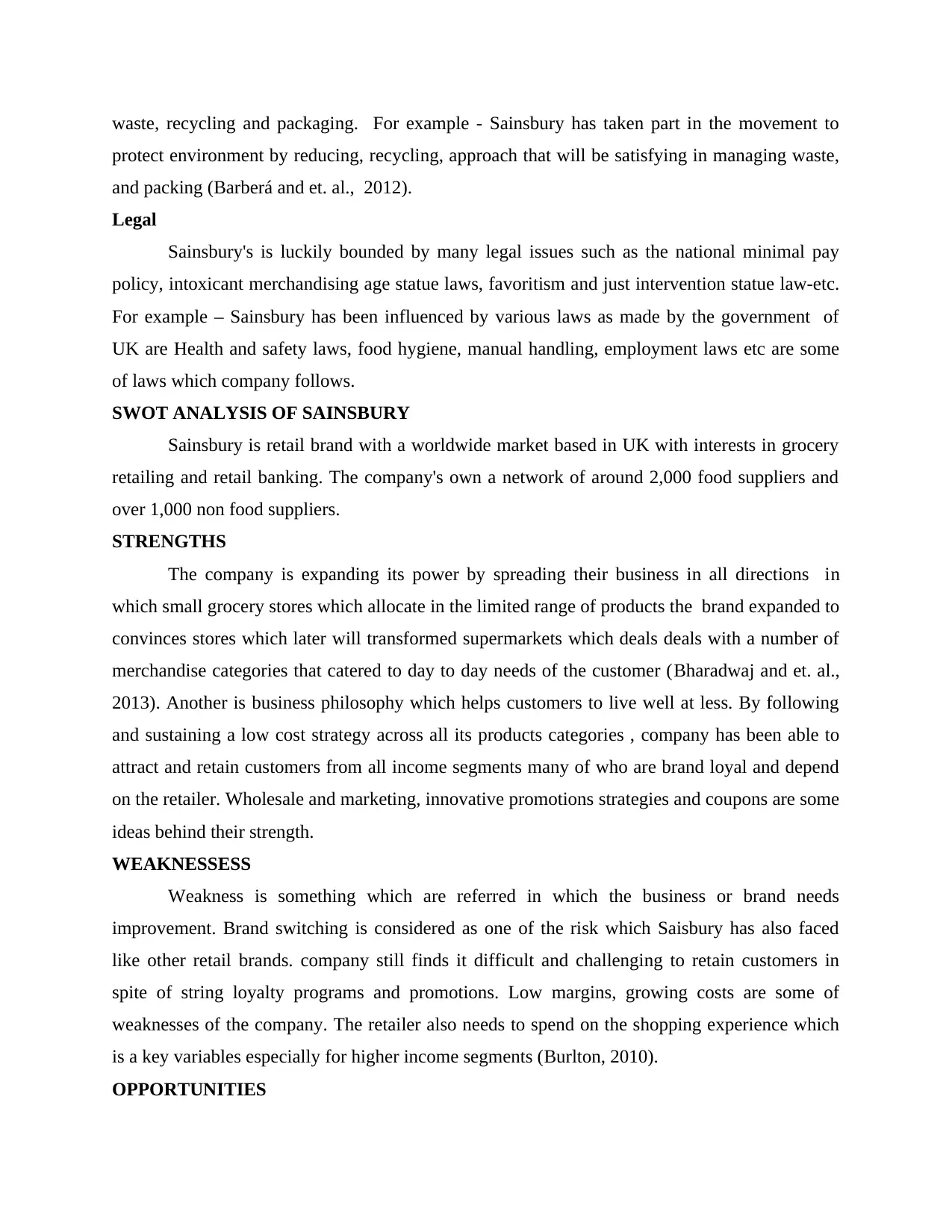
waste, recycling and packaging. For example - Sainsbury has taken part in the movement to
protect environment by reducing, recycling, approach that will be satisfying in managing waste,
and packing (Barberá and et. al., 2012).
Legal
Sainsbury's is luckily bounded by many legal issues such as the national minimal pay
policy, intoxicant merchandising age statue laws, favoritism and just intervention statue law-etc.
For example – Sainsbury has been influenced by various laws as made by the government of
UK are Health and safety laws, food hygiene, manual handling, employment laws etc are some
of laws which company follows.
SWOT ANALYSIS OF SAINSBURY
Sainsbury is retail brand with a worldwide market based in UK with interests in grocery
retailing and retail banking. The company's own a network of around 2,000 food suppliers and
over 1,000 non food suppliers.
STRENGTHS
The company is expanding its power by spreading their business in all directions in
which small grocery stores which allocate in the limited range of products the brand expanded to
convinces stores which later will transformed supermarkets which deals deals with a number of
merchandise categories that catered to day to day needs of the customer (Bharadwaj and et. al.,
2013). Another is business philosophy which helps customers to live well at less. By following
and sustaining a low cost strategy across all its products categories , company has been able to
attract and retain customers from all income segments many of who are brand loyal and depend
on the retailer. Wholesale and marketing, innovative promotions strategies and coupons are some
ideas behind their strength.
WEAKNESSESS
Weakness is something which are referred in which the business or brand needs
improvement. Brand switching is considered as one of the risk which Saisbury has also faced
like other retail brands. company still finds it difficult and challenging to retain customers in
spite of string loyalty programs and promotions. Low margins, growing costs are some of
weaknesses of the company. The retailer also needs to spend on the shopping experience which
is a key variables especially for higher income segments (Burlton, 2010).
OPPORTUNITIES
protect environment by reducing, recycling, approach that will be satisfying in managing waste,
and packing (Barberá and et. al., 2012).
Legal
Sainsbury's is luckily bounded by many legal issues such as the national minimal pay
policy, intoxicant merchandising age statue laws, favoritism and just intervention statue law-etc.
For example – Sainsbury has been influenced by various laws as made by the government of
UK are Health and safety laws, food hygiene, manual handling, employment laws etc are some
of laws which company follows.
SWOT ANALYSIS OF SAINSBURY
Sainsbury is retail brand with a worldwide market based in UK with interests in grocery
retailing and retail banking. The company's own a network of around 2,000 food suppliers and
over 1,000 non food suppliers.
STRENGTHS
The company is expanding its power by spreading their business in all directions in
which small grocery stores which allocate in the limited range of products the brand expanded to
convinces stores which later will transformed supermarkets which deals deals with a number of
merchandise categories that catered to day to day needs of the customer (Bharadwaj and et. al.,
2013). Another is business philosophy which helps customers to live well at less. By following
and sustaining a low cost strategy across all its products categories , company has been able to
attract and retain customers from all income segments many of who are brand loyal and depend
on the retailer. Wholesale and marketing, innovative promotions strategies and coupons are some
ideas behind their strength.
WEAKNESSESS
Weakness is something which are referred in which the business or brand needs
improvement. Brand switching is considered as one of the risk which Saisbury has also faced
like other retail brands. company still finds it difficult and challenging to retain customers in
spite of string loyalty programs and promotions. Low margins, growing costs are some of
weaknesses of the company. The retailer also needs to spend on the shopping experience which
is a key variables especially for higher income segments (Burlton, 2010).
OPPORTUNITIES
⊘ This is a preview!⊘
Do you want full access?
Subscribe today to unlock all pages.

Trusted by 1+ million students worldwide
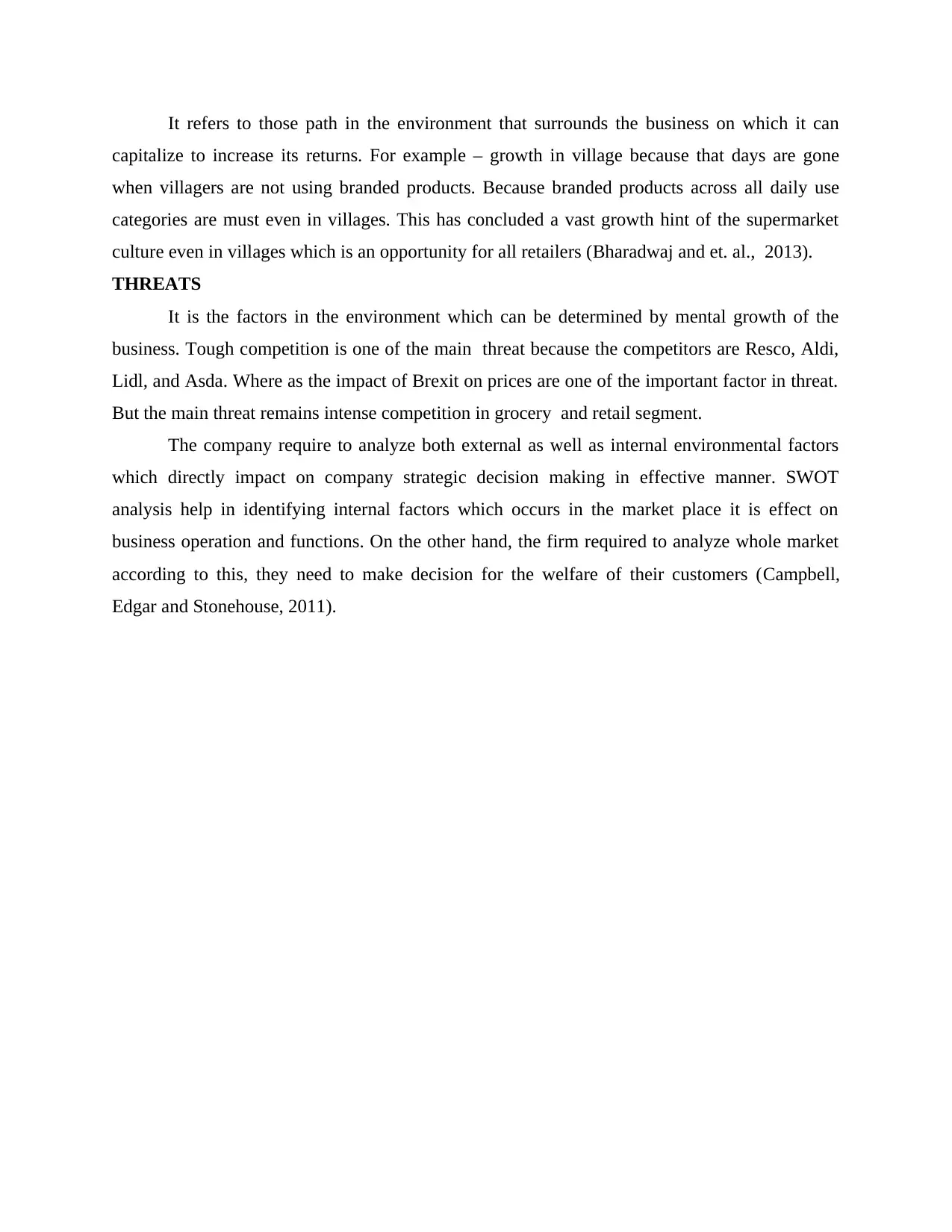
It refers to those path in the environment that surrounds the business on which it can
capitalize to increase its returns. For example – growth in village because that days are gone
when villagers are not using branded products. Because branded products across all daily use
categories are must even in villages. This has concluded a vast growth hint of the supermarket
culture even in villages which is an opportunity for all retailers (Bharadwaj and et. al., 2013).
THREATS
It is the factors in the environment which can be determined by mental growth of the
business. Tough competition is one of the main threat because the competitors are Resco, Aldi,
Lidl, and Asda. Where as the impact of Brexit on prices are one of the important factor in threat.
But the main threat remains intense competition in grocery and retail segment.
The company require to analyze both external as well as internal environmental factors
which directly impact on company strategic decision making in effective manner. SWOT
analysis help in identifying internal factors which occurs in the market place it is effect on
business operation and functions. On the other hand, the firm required to analyze whole market
according to this, they need to make decision for the welfare of their customers (Campbell,
Edgar and Stonehouse, 2011).
capitalize to increase its returns. For example – growth in village because that days are gone
when villagers are not using branded products. Because branded products across all daily use
categories are must even in villages. This has concluded a vast growth hint of the supermarket
culture even in villages which is an opportunity for all retailers (Bharadwaj and et. al., 2013).
THREATS
It is the factors in the environment which can be determined by mental growth of the
business. Tough competition is one of the main threat because the competitors are Resco, Aldi,
Lidl, and Asda. Where as the impact of Brexit on prices are one of the important factor in threat.
But the main threat remains intense competition in grocery and retail segment.
The company require to analyze both external as well as internal environmental factors
which directly impact on company strategic decision making in effective manner. SWOT
analysis help in identifying internal factors which occurs in the market place it is effect on
business operation and functions. On the other hand, the firm required to analyze whole market
according to this, they need to make decision for the welfare of their customers (Campbell,
Edgar and Stonehouse, 2011).
Paraphrase This Document
Need a fresh take? Get an instant paraphrase of this document with our AI Paraphraser
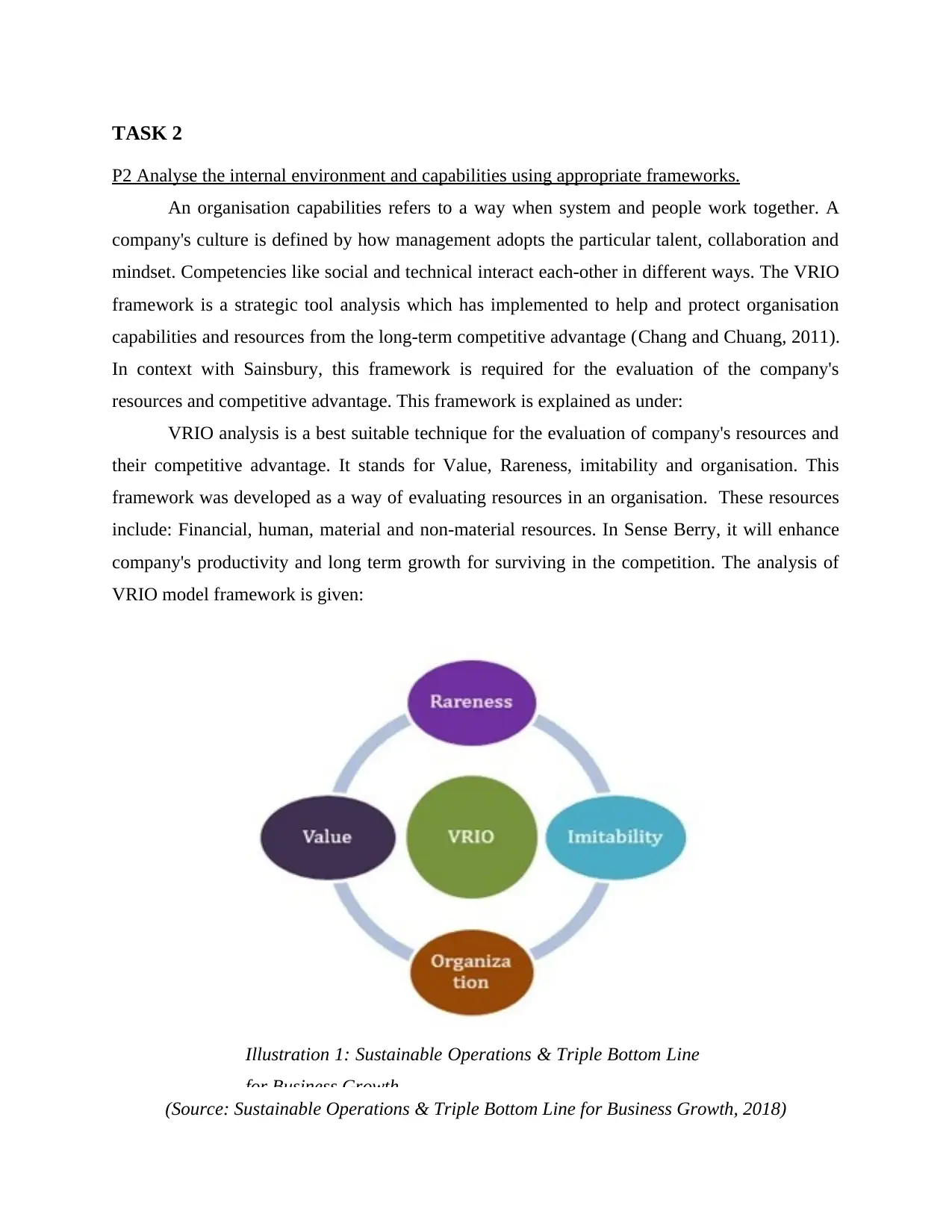
TASK 2
P2 Analyse the internal environment and capabilities using appropriate frameworks.
An organisation capabilities refers to a way when system and people work together. A
company's culture is defined by how management adopts the particular talent, collaboration and
mindset. Competencies like social and technical interact each-other in different ways. The VRIO
framework is a strategic tool analysis which has implemented to help and protect organisation
capabilities and resources from the long-term competitive advantage (Chang and Chuang, 2011).
In context with Sainsbury, this framework is required for the evaluation of the company's
resources and competitive advantage. This framework is explained as under:
VRIO analysis is a best suitable technique for the evaluation of company's resources and
their competitive advantage. It stands for Value, Rareness, imitability and organisation. This
framework was developed as a way of evaluating resources in an organisation. These resources
include: Financial, human, material and non-material resources. In Sense Berry, it will enhance
company's productivity and long term growth for surviving in the competition. The analysis of
VRIO model framework is given:
(Source: Sustainable Operations & Triple Bottom Line for Business Growth, 2018)
Illustration 1: Sustainable Operations & Triple Bottom Line
for Business Growth
P2 Analyse the internal environment and capabilities using appropriate frameworks.
An organisation capabilities refers to a way when system and people work together. A
company's culture is defined by how management adopts the particular talent, collaboration and
mindset. Competencies like social and technical interact each-other in different ways. The VRIO
framework is a strategic tool analysis which has implemented to help and protect organisation
capabilities and resources from the long-term competitive advantage (Chang and Chuang, 2011).
In context with Sainsbury, this framework is required for the evaluation of the company's
resources and competitive advantage. This framework is explained as under:
VRIO analysis is a best suitable technique for the evaluation of company's resources and
their competitive advantage. It stands for Value, Rareness, imitability and organisation. This
framework was developed as a way of evaluating resources in an organisation. These resources
include: Financial, human, material and non-material resources. In Sense Berry, it will enhance
company's productivity and long term growth for surviving in the competition. The analysis of
VRIO model framework is given:
(Source: Sustainable Operations & Triple Bottom Line for Business Growth, 2018)
Illustration 1: Sustainable Operations & Triple Bottom Line
for Business Growth
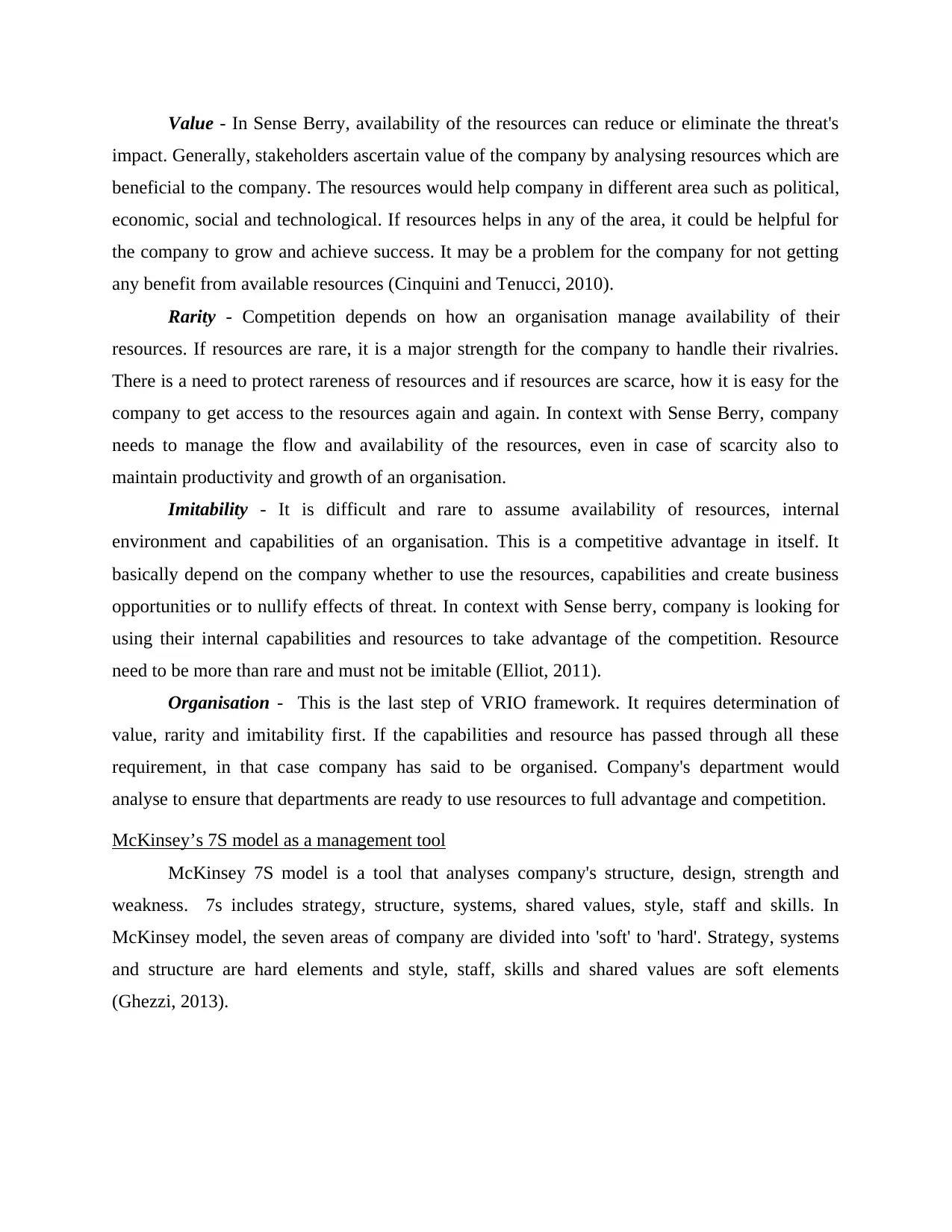
Value - In Sense Berry, availability of the resources can reduce or eliminate the threat's
impact. Generally, stakeholders ascertain value of the company by analysing resources which are
beneficial to the company. The resources would help company in different area such as political,
economic, social and technological. If resources helps in any of the area, it could be helpful for
the company to grow and achieve success. It may be a problem for the company for not getting
any benefit from available resources (Cinquini and Tenucci, 2010).
Rarity - Competition depends on how an organisation manage availability of their
resources. If resources are rare, it is a major strength for the company to handle their rivalries.
There is a need to protect rareness of resources and if resources are scarce, how it is easy for the
company to get access to the resources again and again. In context with Sense Berry, company
needs to manage the flow and availability of the resources, even in case of scarcity also to
maintain productivity and growth of an organisation.
Imitability - It is difficult and rare to assume availability of resources, internal
environment and capabilities of an organisation. This is a competitive advantage in itself. It
basically depend on the company whether to use the resources, capabilities and create business
opportunities or to nullify effects of threat. In context with Sense berry, company is looking for
using their internal capabilities and resources to take advantage of the competition. Resource
need to be more than rare and must not be imitable (Elliot, 2011).
Organisation - This is the last step of VRIO framework. It requires determination of
value, rarity and imitability first. If the capabilities and resource has passed through all these
requirement, in that case company has said to be organised. Company's department would
analyse to ensure that departments are ready to use resources to full advantage and competition.
McKinsey’s 7S model as a management tool
McKinsey 7S model is a tool that analyses company's structure, design, strength and
weakness. 7s includes strategy, structure, systems, shared values, style, staff and skills. In
McKinsey model, the seven areas of company are divided into 'soft' to 'hard'. Strategy, systems
and structure are hard elements and style, staff, skills and shared values are soft elements
(Ghezzi, 2013).
impact. Generally, stakeholders ascertain value of the company by analysing resources which are
beneficial to the company. The resources would help company in different area such as political,
economic, social and technological. If resources helps in any of the area, it could be helpful for
the company to grow and achieve success. It may be a problem for the company for not getting
any benefit from available resources (Cinquini and Tenucci, 2010).
Rarity - Competition depends on how an organisation manage availability of their
resources. If resources are rare, it is a major strength for the company to handle their rivalries.
There is a need to protect rareness of resources and if resources are scarce, how it is easy for the
company to get access to the resources again and again. In context with Sense Berry, company
needs to manage the flow and availability of the resources, even in case of scarcity also to
maintain productivity and growth of an organisation.
Imitability - It is difficult and rare to assume availability of resources, internal
environment and capabilities of an organisation. This is a competitive advantage in itself. It
basically depend on the company whether to use the resources, capabilities and create business
opportunities or to nullify effects of threat. In context with Sense berry, company is looking for
using their internal capabilities and resources to take advantage of the competition. Resource
need to be more than rare and must not be imitable (Elliot, 2011).
Organisation - This is the last step of VRIO framework. It requires determination of
value, rarity and imitability first. If the capabilities and resource has passed through all these
requirement, in that case company has said to be organised. Company's department would
analyse to ensure that departments are ready to use resources to full advantage and competition.
McKinsey’s 7S model as a management tool
McKinsey 7S model is a tool that analyses company's structure, design, strength and
weakness. 7s includes strategy, structure, systems, shared values, style, staff and skills. In
McKinsey model, the seven areas of company are divided into 'soft' to 'hard'. Strategy, systems
and structure are hard elements and style, staff, skills and shared values are soft elements
(Ghezzi, 2013).
⊘ This is a preview!⊘
Do you want full access?
Subscribe today to unlock all pages.

Trusted by 1+ million students worldwide
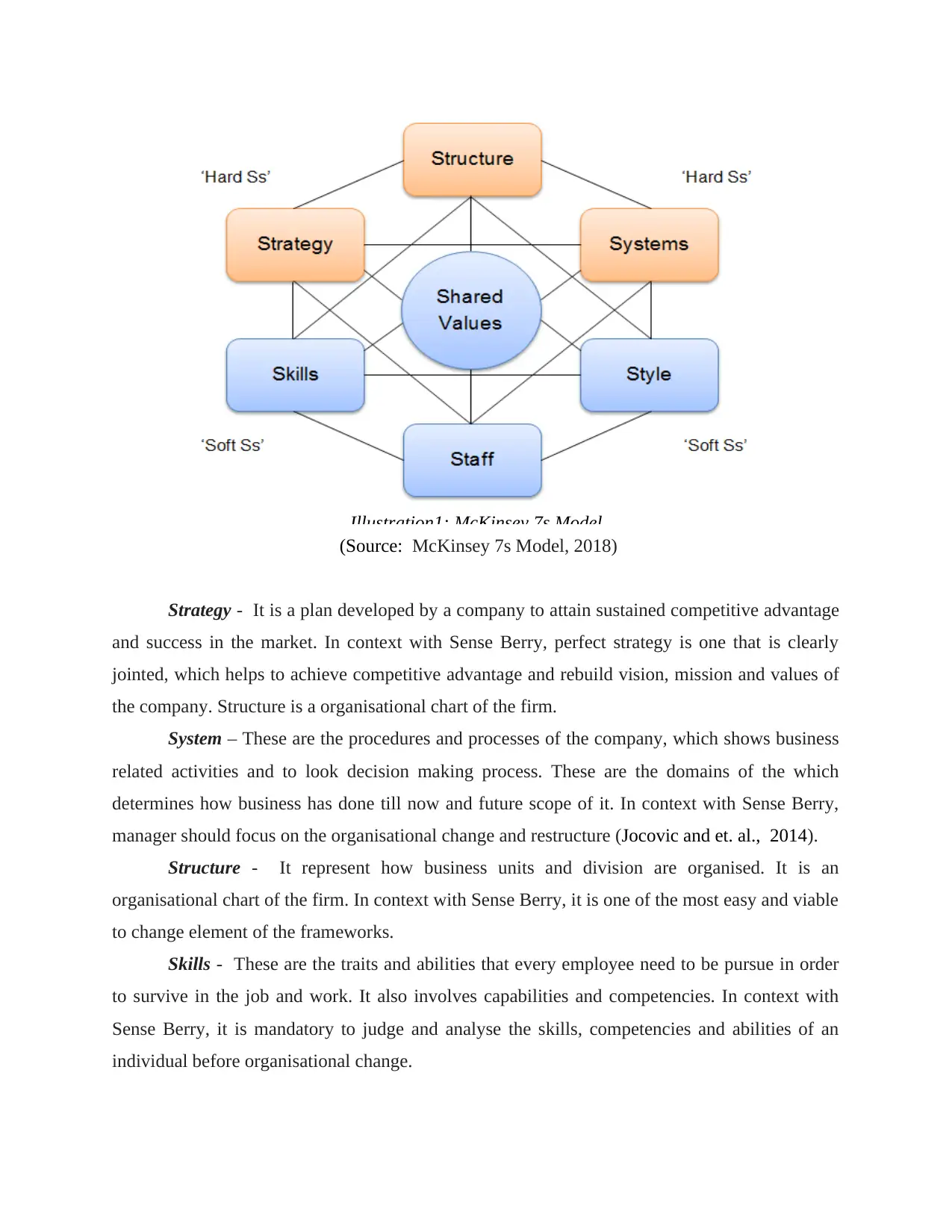
(Source: McKinsey 7s Model, 2018)
Strategy - It is a plan developed by a company to attain sustained competitive advantage
and success in the market. In context with Sense Berry, perfect strategy is one that is clearly
jointed, which helps to achieve competitive advantage and rebuild vision, mission and values of
the company. Structure is a organisational chart of the firm.
System – These are the procedures and processes of the company, which shows business
related activities and to look decision making process. These are the domains of the which
determines how business has done till now and future scope of it. In context with Sense Berry,
manager should focus on the organisational change and restructure (Jocovic and et. al., 2014).
Structure - It represent how business units and division are organised. It is an
organisational chart of the firm. In context with Sense Berry, it is one of the most easy and viable
to change element of the frameworks.
Skills - These are the traits and abilities that every employee need to be pursue in order
to survive in the job and work. It also involves capabilities and competencies. In context with
Sense Berry, it is mandatory to judge and analyse the skills, competencies and abilities of an
individual before organisational change.
Illustration1: McKinsey 7s Model
Strategy - It is a plan developed by a company to attain sustained competitive advantage
and success in the market. In context with Sense Berry, perfect strategy is one that is clearly
jointed, which helps to achieve competitive advantage and rebuild vision, mission and values of
the company. Structure is a organisational chart of the firm.
System – These are the procedures and processes of the company, which shows business
related activities and to look decision making process. These are the domains of the which
determines how business has done till now and future scope of it. In context with Sense Berry,
manager should focus on the organisational change and restructure (Jocovic and et. al., 2014).
Structure - It represent how business units and division are organised. It is an
organisational chart of the firm. In context with Sense Berry, it is one of the most easy and viable
to change element of the frameworks.
Skills - These are the traits and abilities that every employee need to be pursue in order
to survive in the job and work. It also involves capabilities and competencies. In context with
Sense Berry, it is mandatory to judge and analyse the skills, competencies and abilities of an
individual before organisational change.
Illustration1: McKinsey 7s Model
Paraphrase This Document
Need a fresh take? Get an instant paraphrase of this document with our AI Paraphraser
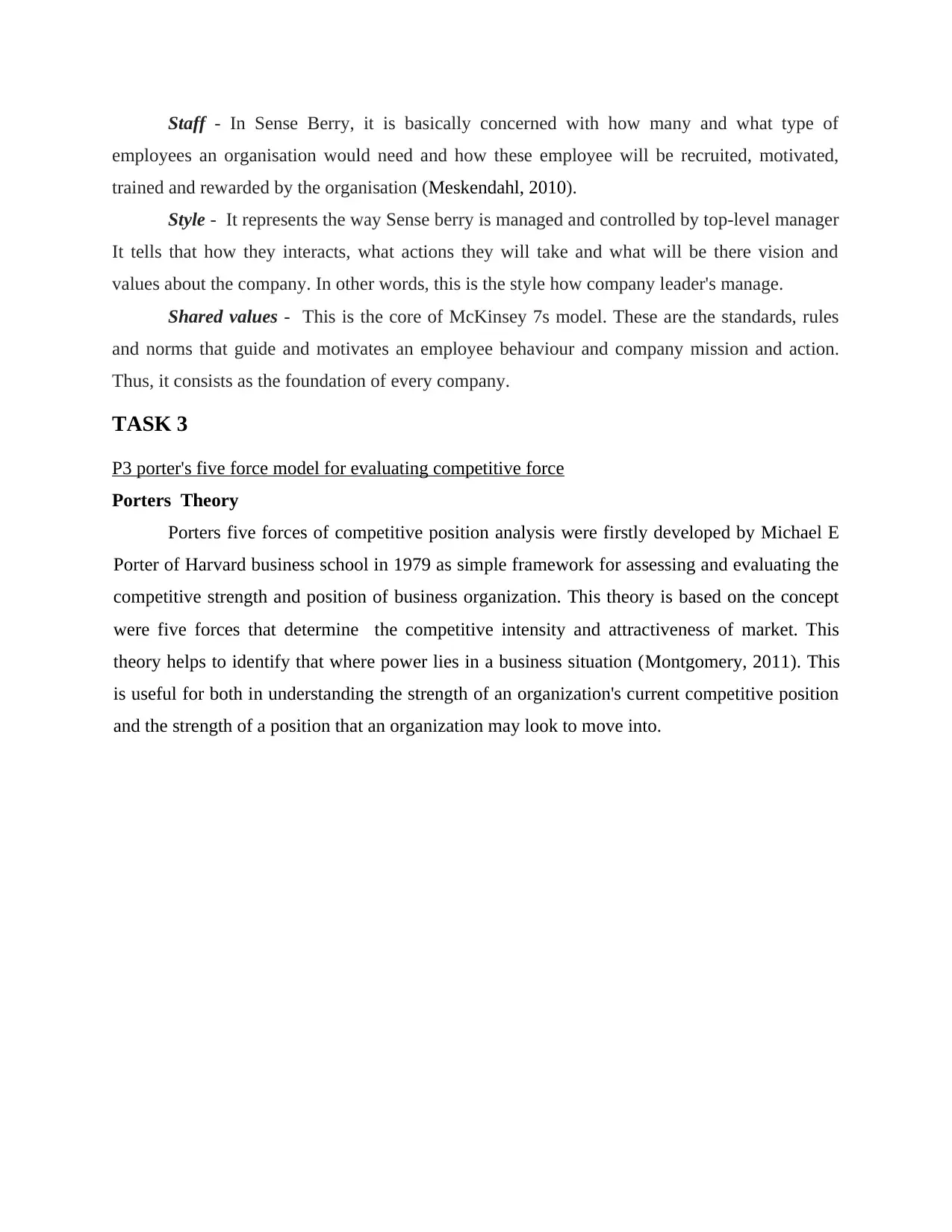
Staff - In Sense Berry, it is basically concerned with how many and what type of
employees an organisation would need and how these employee will be recruited, motivated,
trained and rewarded by the organisation (Meskendahl, 2010).
Style - It represents the way Sense berry is managed and controlled by top-level manager
It tells that how they interacts, what actions they will take and what will be there vision and
values about the company. In other words, this is the style how company leader's manage.
Shared values - This is the core of McKinsey 7s model. These are the standards, rules
and norms that guide and motivates an employee behaviour and company mission and action.
Thus, it consists as the foundation of every company.
TASK 3
P3 porter's five force model for evaluating competitive force
Porters Theory
Porters five forces of competitive position analysis were firstly developed by Michael E
Porter of Harvard business school in 1979 as simple framework for assessing and evaluating the
competitive strength and position of business organization. This theory is based on the concept
were five forces that determine the competitive intensity and attractiveness of market. This
theory helps to identify that where power lies in a business situation (Montgomery, 2011). This
is useful for both in understanding the strength of an organization's current competitive position
and the strength of a position that an organization may look to move into.
employees an organisation would need and how these employee will be recruited, motivated,
trained and rewarded by the organisation (Meskendahl, 2010).
Style - It represents the way Sense berry is managed and controlled by top-level manager
It tells that how they interacts, what actions they will take and what will be there vision and
values about the company. In other words, this is the style how company leader's manage.
Shared values - This is the core of McKinsey 7s model. These are the standards, rules
and norms that guide and motivates an employee behaviour and company mission and action.
Thus, it consists as the foundation of every company.
TASK 3
P3 porter's five force model for evaluating competitive force
Porters Theory
Porters five forces of competitive position analysis were firstly developed by Michael E
Porter of Harvard business school in 1979 as simple framework for assessing and evaluating the
competitive strength and position of business organization. This theory is based on the concept
were five forces that determine the competitive intensity and attractiveness of market. This
theory helps to identify that where power lies in a business situation (Montgomery, 2011). This
is useful for both in understanding the strength of an organization's current competitive position
and the strength of a position that an organization may look to move into.
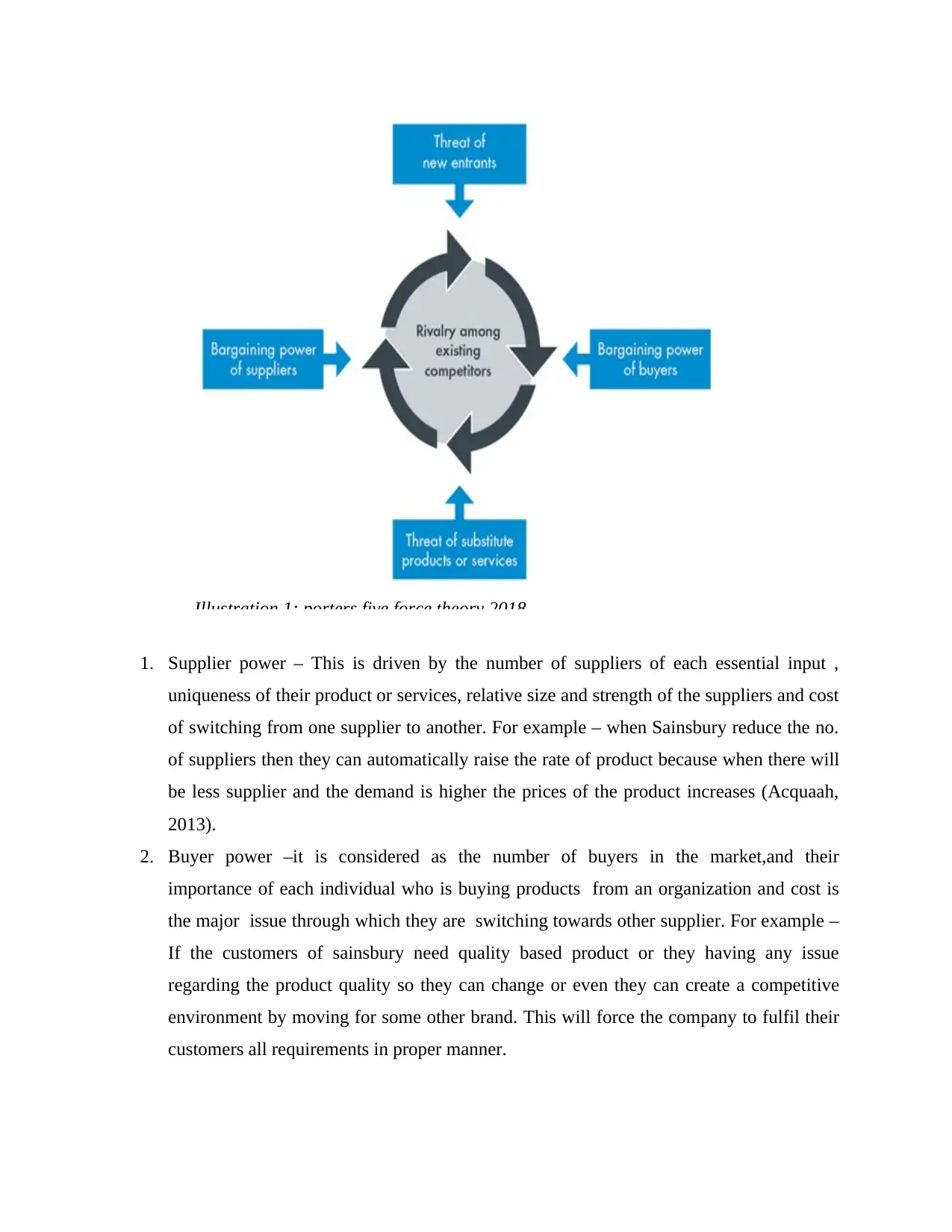
1. Supplier power – This is driven by the number of suppliers of each essential input ,
uniqueness of their product or services, relative size and strength of the suppliers and cost
of switching from one supplier to another. For example – when Sainsbury reduce the no.
of suppliers then they can automatically raise the rate of product because when there will
be less supplier and the demand is higher the prices of the product increases (Acquaah,
2013).
2. Buyer power –it is considered as the number of buyers in the market,and their
importance of each individual who is buying products from an organization and cost is
the major issue through which they are switching towards other supplier. For example –
If the customers of sainsbury need quality based product or they having any issue
regarding the product quality so they can change or even they can create a competitive
environment by moving for some other brand. This will force the company to fulfil their
customers all requirements in proper manner.
Illustration 1: porters five force theory 2018
uniqueness of their product or services, relative size and strength of the suppliers and cost
of switching from one supplier to another. For example – when Sainsbury reduce the no.
of suppliers then they can automatically raise the rate of product because when there will
be less supplier and the demand is higher the prices of the product increases (Acquaah,
2013).
2. Buyer power –it is considered as the number of buyers in the market,and their
importance of each individual who is buying products from an organization and cost is
the major issue through which they are switching towards other supplier. For example –
If the customers of sainsbury need quality based product or they having any issue
regarding the product quality so they can change or even they can create a competitive
environment by moving for some other brand. This will force the company to fulfil their
customers all requirements in proper manner.
Illustration 1: porters five force theory 2018
⊘ This is a preview!⊘
Do you want full access?
Subscribe today to unlock all pages.

Trusted by 1+ million students worldwide
1 out of 20
Related Documents
Your All-in-One AI-Powered Toolkit for Academic Success.
+13062052269
info@desklib.com
Available 24*7 on WhatsApp / Email
![[object Object]](/_next/static/media/star-bottom.7253800d.svg)
Unlock your academic potential
Copyright © 2020–2025 A2Z Services. All Rights Reserved. Developed and managed by ZUCOL.




